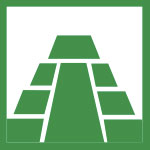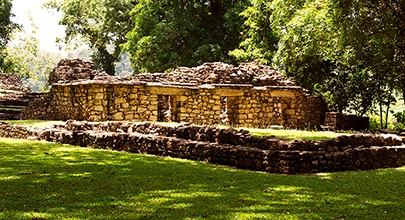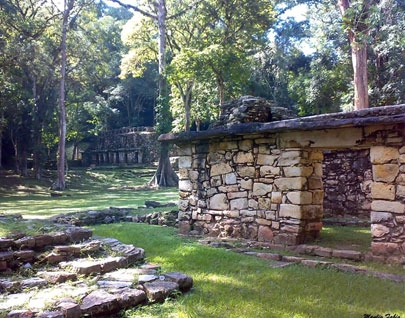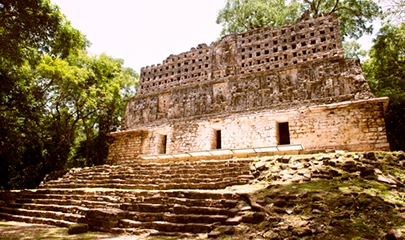
A splendid setting of tall evergreen forests shelters this magnificent archaeological zone, famous for its sculptural art evident in stelae and lintels. To build it, the Maya took advantage of the terrain of a peninsula surrounded by a meander of the river. Yaxchilan took place between 350 and 810 AD.
The area of the city is very extensive but nowadays its visit is restricted to part of the Great Plaza, the Great Acropolis, the Small Acropolis and the South Acropolis. The Great Plaza is accessed through building 19, also known as the Labyrinth, due to the complex distribution of its rooms. In the center of the square is the ball court and small groups of buildings that in some cases seem to have served as palaces.
In several of the constructions lintels that narrate the dynastic history of the city are conserved. Those of buildings 12 and 22 stand out. Over the plaza rises the great stela 1, which shows Pájaro Jaguar IV with a royal ceremonial dress.
A bunch of emotions will accompany you when you climb the staircase that connects the square with the Great Acropolis presided over by the magnificent building 33, the largest in the city. The cresting, its hieroglyphic staircase with scenes of the Jaguar Bird IV playing ball, the lintels, the decapitated sculpture of the same character inside, are its most outstanding feature.
A Lacandon legend says that when the head of the Jaguar Bird returns to its place, the world will be devastated by the celestial jaguars. In front of the temple you can see Stela 31 carved in stalactite.
Through paths in the jungle you reach the South Acropolis and the Small Acropolis. The first is formed by buildings 39 and 40, and there are remains of mural paintings. Two squares form The Small or West Acropolis, around them the buildings are distributed. The most outstanding are numbers 42 and 44. The characteristics of the restricted area of this complex suggest that ceremonies were held there for a very select group of people. Building 44 is a monument to the conquests of Escudo Jaguar I, who ruled Yaxchilán between the 7th and 8th centuries A.D., and which are uniquely engraved on the six access steps.
How to get there:
The Yaxchilán archaeological zone can be accessed from Palenque, Chiapas; following the highway (Fronteriza del Sur) that leads southeast, to the town of Chancalá, about 40 kilometers away. Continue on the same road towards Boca del Lacantún, traveling approximately 105 kilometers, until you reach the Frontera Corozal or Frontera Echeverría crossing; turn northeast, continue for 15 kilometers to the town of Frontera Corozal on the banks of the Usumacinta River. In Frontera Corozal and following the course of the Usumacinta River, after 30 kilometers by river, you disembark at the archaeological zone.
Schedule:
Monday to Sunday from 08:00 to 17:00.
Cost:
At the moment there is no collection fee from (The National Institute of Anthropology and History) INAH, it is done by the community. ($ 70.00 MXN)
For your convenience:
-
Restrooms
-
Security personnel
-
Resting areas in the service module
-
Restaurant with capacity for 150 people
Activities:
- Recorrido en lancha.
Recommendations:
(The National Institute of Anthropology and History) recommends wearing comfortable clothes, being willing to walk a lot and climb the Acropolis. Bring a hat and mosquito repellent, binoculars and water.
360 tour
Fair in Honor of Saint Sebastian Martyr
Zinacantán, Chiapas
Candelaria Fair, Cintalapa de Figueroa
Cintalapa, Chiapas
Descent of the Little Virgins of Copoya
Tuxtla Gutiérrez, Chiapas
Comitán de Domínguez, Chiapas



